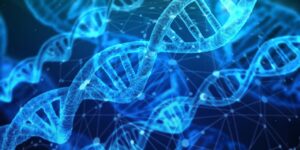Where is the mutagen found?
Heterocyclic amines (HCAs), a group of potent mutagenic compounds, are found in cooked meats, particularly in well-done meats. These carcinogens, which may cause cancer, are formed when meat, poultry, or fish is cooked at high temperatures using methods such as frying, broiling, barbecuing, or grilling. HCAs result from chemical reactions between creatine or creatinine, amino acids, and sugars, with higher levels produced as cooking temperature and duration increase. Pan-frying and grilling generate the highest concentrations of HCAs, which have been shown to induce tumors in experimental animal models and are among the most potent mutagens detected in Ames/Salmonella tests.
Are there any positive uses for Heterocyclic Amines?
Heterocyclic amines, despite their potential mutagenic properties, have several positive uses. Pyridine, a type of heterocyclic amine, is utilized as a flavoring agent in various food products, enhancing taste and aroma. Additionally, pyrimidine and purines, which are also heterocyclic amines, play an essential role in nutrition as components of vitamins B1, B6, and niacin, contributing to vital metabolic functions.
Moreover, purines and pyrimidines are critical to genetic and cellular processes as they form the nucleobases cytosine, uracil, thymine, adenine, and guanine. These nucleobases are the fundamental building blocks of DNA and RNA, which are essential for storing genetic information and supporting cellular activities.
How does the mutagen cause the change in DNA?
Heterocyclic amines (HCAs) cause changes in DNA by forming covalent bonds with DNA molecules, known as DNA adducts, during metabolic activation. When HCAs are metabolically activated by enzymes such as cytochrome P450 1A2, the amino group undergoes oxidation, followed by acetylation or sulfation. This process creates highly reactive mutagenic intermediates, such as nitrenium ions, which interact with cellular macromolecules, including DNA. These interactions result in the formation of DNA adducts that disrupt the genetic code within the DNA strand.
If these DNA adducts are not repaired, they can lead to mutations, which may alter the flow of genetic information in a cell. Such mutations can interfere with normal cellular functions and potentially increase the risk of cancer. HCAs have been shown to be potent mutagens in Ames/Salmonella tests and have been demonstrated to induce tumors in experimental animal models.
What effect can the mutagen eventually cause?
Heterocyclic amines (HCAs) can eventually increase the risk of various cancers, particularly in the digestive and reproductive systems. Studies have linked high HCA intake to cancers of the colon, rectum, breast, prostate, and stomach, with frequent consumption of well-done meats associated with elevated risks of colorectal, pancreatic, and prostate cancers.
How can contact with the mutagen be prevented? Do any human activities cause an increase in contact with the mutagen?
Contact with heterocyclic amines (HCAs) can be minimized by adopting specific cooking practices that reduce their formation. Lowering pan temperatures, shortening cooking times, and frequently turning meat during cooking can significantly decrease HCA production while ensuring bacterial safety. Avoiding direct exposure of meat to open flames or hot metal surfaces, as well as refraining from prolonged cooking at high temperatures, can also help. Using a microwave to precook meat reduces the time it spends in contact with high heat, further lowering HCA levels. Additionally, removing charred portions of meat and avoiding gravy made from meat drippings can reduce exposure to HCAs and related carcinogens like polycyclic aromatic hydrocarbons (PAHs).
On the other hand, certain human activities can increase contact with HCAs. High intake of red and processed meats, as well as cooking methods like grilling, barbecuing, and pan-frying at high temperatures, lead to higher HCA formation. Epidemiological studies have linked frequent consumption of such meats to an increased risk of cancers, including breast, colorectal, and prostate. By adjusting cooking techniques and reducing consumption of overcooked meats, individuals can effectively limit their contact with these harmful mutagens.
Stats associated with the Heterocyclic Amines
I came across statistics linking mutagens, particularly heterocyclic amines (HCAs), to an increased risk of colon cancer. A population-based, case-control study conducted in North Carolina between 1996 and 2000 found a positive association between red meat intake and colon cancer. The study included 701 African-American and 957 White participants and reported odds ratios (OR) for various factors related to meat intake and cooking methods. Specifically, red meat intake was positively associated with colon cancer, with an OR of 2.0 (95% CI (CI= Confidence Interval): 1.3, 3.2). The strongest associations were found for pan-fried red meat (OR = 2.0, 95% CI: 1.4, 3.0) and well/very well-done red meat (OR = 1.7, 95% CI: 1.2, 2.5). The study also noted the strongest association for the HCA 2-amino-3,4,8-trimethylimidazo[4,5-f]quinoxaline (DiMeIQx), with odds ratios ranging from 1.8 to 2.0 across different levels of exposure. These findings suggest a modest, positive relationship between mutagens like HCAs in red meat and the risk of colon cancer.
References:
Butler, L. M. (2003). Heterocyclic Amines, Meat Intake, and Association with Colon Cancer in a Population-based Study. American Journal of Epidemiology, 157(5), 434–445. https://doi.org/10.1093/aje/kwf221
Khalid, M., & Abdollahi, M. (2023). Carcinogen-DNA adduct formation and DNA repair (pp. 589–595). Academic Press. https://doi.org/10.1016/B978-0-12-824315-2.00651-5
https://www.cancer.gov/publications/dictionaries/cancer-terms/def/heterocyclic-amine. (2011, February 2). Www.cancer.gov. https://www.cancer.gov/publications/dictionaries/cancer-terms/def/heterocyclic-amine
Heterocyclic Amine – an overview | ScienceDirect Topics. (n.d.). Www.sciencedirect.com. https://www.sciencedirect.com/topics/pharmacology-toxicology-and-pharmaceutical-science/heterocyclic-amine
Mottram, D. S. (1998). Flavour formation in meat and meat products: a review. Food Chemistry, 62(4), 415–424. https://doi.org/10.1016/s0308-8146(98)00076-4
Salmon, C. P. (2000). Minimization of Heterocyclic Amines and Thermal Inactivation of Escherichia coli in Fried Ground Beef. Journal of the National Cancer Institute, 92(21), 1773–1778. https://doi.org/10.1093/jnci/92.21.1773
Zheng, W., & Lee, S.-A. (2009). Well-Done Meat Intake, Heterocyclic Amine Exposure, and Cancer Risk. Nutrition and Cancer, 61(4), 437–446. https://doi.org/10.1080/01635580802710741
National Cancer Institute. (2017, July 11). Chemicals in Meat Cooked at High Temperatures and Cancer Risk. National Cancer Institute; Cancer.gov. https://www.cancer.gov/about-cancer/causes-prevention/risk/diet/cooked-meats-fact-sheet
Sugimura, T., Wakabayashi, K., Nakagama, H., & Nagao, M. (2004). Heterocyclic amines: Mutagens/carcinogens produced during cooking of meat and fish. Cancer Science, 95(4), 290–299. https://doi.org/10.1111/j.1349-7006.2004.tb03205.x
Carvalho, A. M., Miranda, A. M., Santos, F. A., Loureiro, A. P. M., Fisberg, R. M., & Marchioni, D. M. (2015). High intake of heterocyclic amines from meat is associated with oxidative stress. British Journal of Nutrition, 113(8), 1301–1307. https://doi.org/10.1017/s0007114515000628





